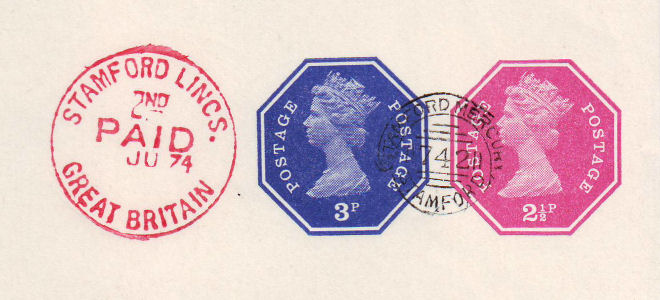|
From 1712 there was duty payable on newspapers that started at ½d per half sheet and increased incrementally to 4d per sheet in 1815 with a discount for paying at least £10 duty at a time and not increasing the newspaper price by more than the duty increase. Payment of these taxes were indicated by red imprints on the sheet. As a dispensation, the newspapers were allowed to pass through the post multiple times for up to 15 days from the publication date. |
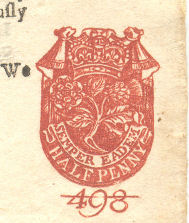
From a 1725 copy of 'The Whitehall Evening Poft' |
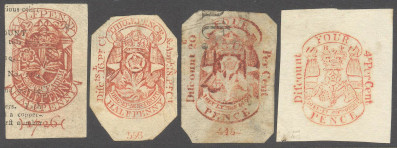
Half-size images of: 1 ½d (still with the Queen Anne motto "Semper Eadem"),
3 ½d, 4d - 20%, 4d - 4% with the King George motto "Dieu et mon Droit" from 1804.
|
At this level of taxation, public pressure mounted and there were cases of newspapers being produced without paying the tax. In 1836 the tax was reduced to 1d with the proviso that stamped paper could be withheld from publishers failing to pay their advertisement tax on time. As a way of enforcing this, it was also required for the impressed stamp to include the newspaper name to prevent a black-market in stamped-paper: |


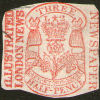
Half-size images of 3 "ONE PENNY" tax stamps and a much less common "THREE HALFPENCE". |
These red imprints were still done the 'old-fashioned way', that is, the paper had to be taken to Somerset House for the tax-stamp before printing. Needless to say, with the increasing output of newspapers, especially now they were cheaper, this placed a great burden on all concerned. These red imprints were also used on circulars. The illustration below shows a circular of E. Zwilchenbart & Co. Merchants of 5 Rumford Street, Liverpool printed by George J, Poore of 42 Castle Street and relates to cotton goods. It is in French and is dated 30 May 1853. The white mark at the top is presumably where an address was glued in place. |
|
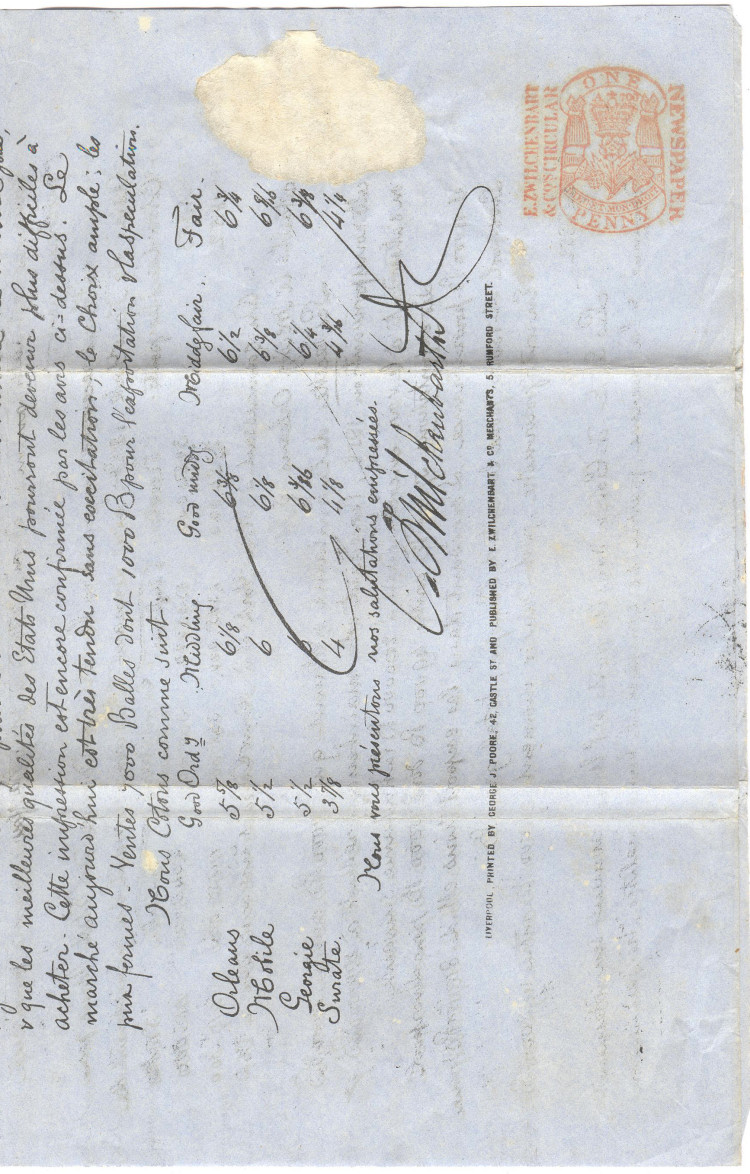
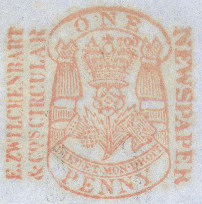
|
From 1853 (after 18 years of campaigning by Rowland Hill) some of the main newspapers were enabled to print their own stamps (in black) as part of the printing process, while using a counter for accounting purposes.
Though this was still illegal, the only ones who could take action against them were the Commissioners of Inland Revenue who also wanted the changes and in fact actively assisted in the work involved (Ref. Philbrick & Westoby 1881).
According to Chandler, The Times was the first to use this system, starting 18 October 1853,
followed by the Stamford Mercury in 1856 and the Illustrated London News in 1859. |
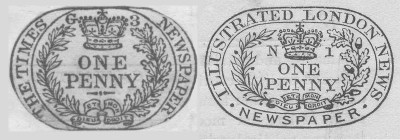
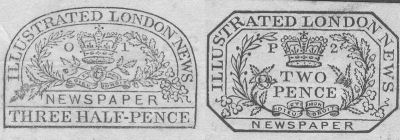
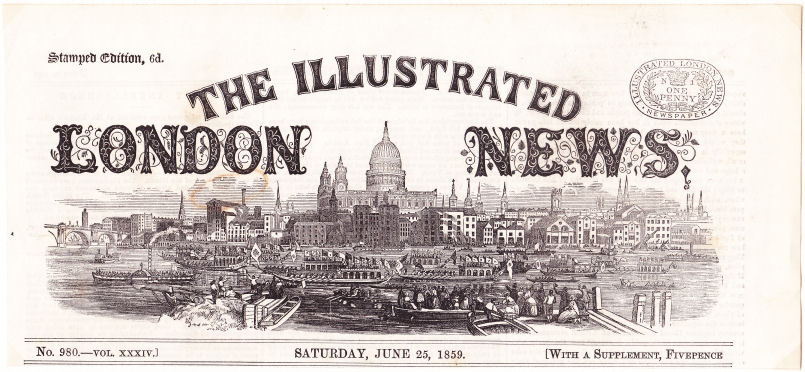
Illustrated London News banner of 25 June 1859 courtesy of John Hines.
Below is a One Halfpenny for the Times Supplement dated 2nd February 1854.
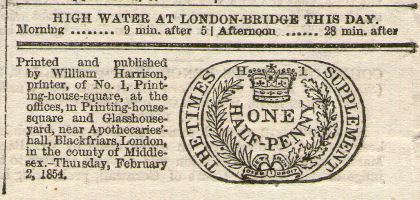
Philbrick & Westoby give the following dates for the various dies used:
| value | Die | Times |
|---|
| 1d | G1 | 18 Oct. 1853 to December 1858 |
| 1d | G3 | January 1859 to 30 Sept. 1870 |
| ½d | H1 | 9 Nov. 1859 to 30 June 1855 |
| 1½d | K1 | 1 July 1855 to December 1858 |
| 1½d | K3 | January 1858[SIC] to 30 Sept. 1870 |
| 2d | L1 | 1 July 1855 to 30 Sept. 1870 |
| value | Die | Illustrated London News |
|---|
| 1d | N1 | These |
| 1d | N2 | were |
| 1½d | O1 | all used |
| 1½d | O3 | indiscriminately |
| 2d | P1 | between |
| 2d | P2 |
1859 and 1870 |
| value | Die | Stamford Mercury |
|---|
| 1d | Q1 | 1856 to 30 September 1870 |
|
Initially the one penny rate was the only option and simply allowed them to be posted within London or to be posted and delivered within the postal limits of the same town. However the Government wanted newspapers to be more widely distributed, and also they were being accused of having a 'tax on knowledge' and on 30th June 1855, the tax was abolished and newspapers could pass through the post at the 'Book-Post' rate of one penny per 4oz. This led to the introduction of the three half pence and two penny stamps.
The newspapers that still used the old red tax stamps could continue to use them as postage stamps (although the proceeds went to the Inland Revenue, rather than the Post Office) allowing them free postage (sometimes multiple times) for up to 15 days. Some Newspapers chose to do this until the revenue stamps were abolished in 1870.
|
| From 1865 a number of private companies, principally in Scotland started advertising cheap local deliveries of circulars and parcels for ¼d or ½d. This gradually spread south despite the fact that legally the Post Office had a monopoly on such delivery. In 1867 the Post Office took legal action and the companies were shut down, but the point had been made and public opinion mobilized. |
|
A selection of 1865-68 local issues
A penny red is shown for size comparison, I have used one with Freemason markings for interest sake.
|
The Post Office Act that came into force from 1/10/1870 implemented a cheap rate of ½d per 2 ounces for newspaper and circular postage. The Times, Illustrated London News and Stamford Mercury were given the option of using normal stamped wrappers (like other newspapers) or continuing their present system. The Illustrated London News decided to use stamped wrappers, whilst the other two wanted to continue as they were. Since now the newspapers could only pass through the post once, it was necessary to cancel the stamps. This was done in the form of a precancel:
For other newspapers that needed to pass through the post, normal stamps were used with or without wrappers.
This example is on 'The Market Harborough Advertiser' dated January 25, 1876 with 1d red plate 150
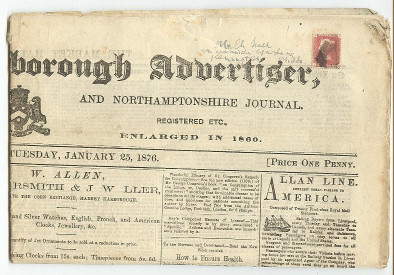
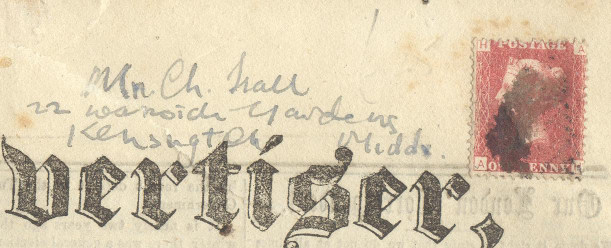
Getting back to precancels:
The Times precancel exists in several similar fonts lettered 'AA', 'AB' and (reportedly, Stitt Dibden) 'AC' as shown below. They were registered 30/9/1870 and were used until 1911.
Details can be found in 'The Newspaper and Almanac Stamps of Great Britain and Ireland' by John H. Chandler & H. Dagnall.
According to them, the privilege of using these dies was given up on 21st October 1911 and adhesive stamps used on wrappers until the adoption of Meter Franking in 1925. |
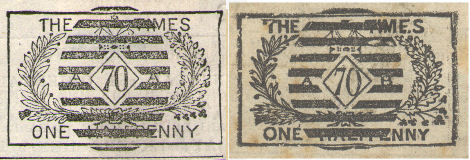
The Times Halfpenny precancel. The '70' appears to be Anerley S.E. London, but according to Chandler & Dagnall was the number in the P.O. series allocated to the N.P.B.
Philbrick & Westoby (1881) says that it denoted "the distinguishing number of the newspaper office in the chief office at St. Martin's le Grand."
They only mention die 'A B' but die 'A A' also exists
|
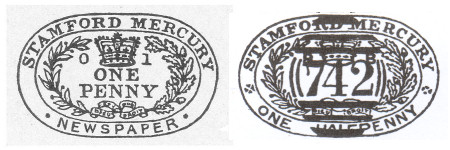
The Stamford Mercury Halfpenny precancel was adapted from the One Penny. The '742' being Stamford - see below.
|
The Stamford Mercury (established 1710) Precancel had four similar types with variations most notably in the side ornaments.
They were all lettered 'BB' and were registered 3/10/1870 and used until 21/11/1878
In 1878 Stamford Mercury was obliged to discontinue printing the precancels onto their newspapers and use a system similar to the 'public' precancels with the difference that the Post Office used a named precancel on their wrappers from 28/11/1878. These design incorporated the Stamford barred oval shown here:
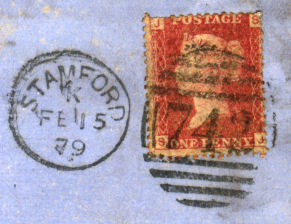
Below are examples of the Stamford Mercury wrapper precancel, still in use in Elizabethan times! Note the '742' 1844 style mark for Stamford. According to Huggins/Baker, this Stamford Mercury wrapper precancel is known on
the 2d, 2½d, 3d, 5d and 6d values of this type.
The 5d and 6d values were first produced in 1961.
The bottom one here they list as WS139 with a note that it was used by Stamford Mercury. It has a note on the back 'March 22 74'.
|
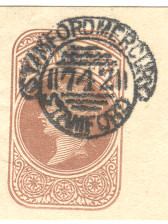 |
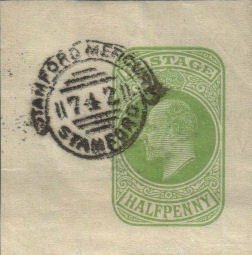 |
| |
|
|
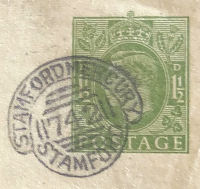
Courtesy of Andrew Chappell. |
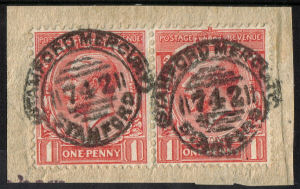
Block Cypher watermark, 1924 type. |
| |
|
|
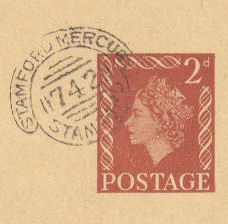 |
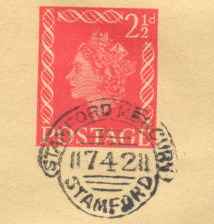 |
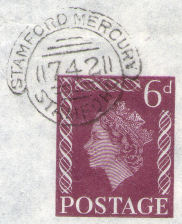 |
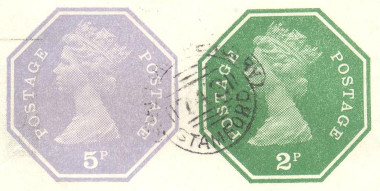 |
Is this the longest-lived precancel at over 90 years?
The Edwardian and George V. examples are both courtesy of Dave Lewis |
Shown below are two other designs proposed by the Post Office but rejected by the Stamford Mercury.
It is interesting to note that if the one on the left had been accepted it would have been the first squared circle postmark in the world. As it was, the honour went to Leeds on September 1879.
The Stamford Mercury chose the one on the right with the proviso that they could use their 742 ‘logo’ instead of the date which was unworkable due to the difficulties of predicting in advance how many they would need on a particular day.
Their precancel could still be considered to be the first 'Hooded Circle' though.
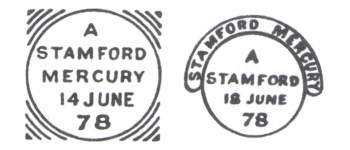
|


